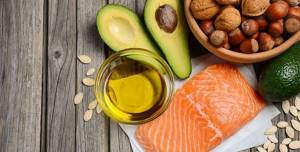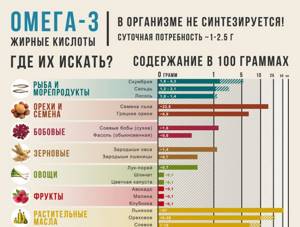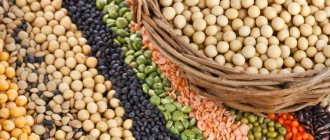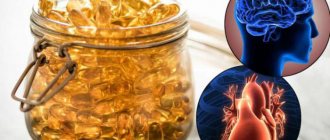They were discovered in the 50s of the 20th century, but medical scientists began to pay special attention to them only 20 years later. Doctors from Denmark began to study their effect on the body of Eskimos from Greenland, who live much longer than Europeans. Thanks to research, it turned out that the Eskimos practically did not suffer from hypertension, thrombosis, atherosclerosis and other heart-related diseases. They consumed a lot of sea fish - this food is rich in this natural “ingredient”.
A study of the blood composition of the inhabitants of Greenland made it possible to understand that the consumption of this component is extremely beneficial for the body. Docosahexaenoic, eicosapentaenoic and alpha-linolenic acids perform a protective function for internal organs and prevent blood from thickening. They also prevent joint inflammation, maintain nail strength and skin elasticity, and have a positive effect on hair, blood vessels and visual acuity. If you want to give birth to a healthy child, then this component is recommended for daily consumption.
Maintaining Omega-3 Balance
As for the consumption rate, it is important to maintain the proportions between the consumption of Omega-3 and Omega-6. The proportion should be 5:1 (Omega three should be less). Omega-6 is found in sunflower and butter or pork. To balance your diet, just add flaxseed oil, nuts and seafood to your daily diet (at least once a week).
California Gold Nutrition, Omega-3, Premium Fish Oil, 100 Fish Gelatin Capsules
★★★★★
549 ₽
Buy at a discount
One of the main sources of this type of element is fish oil, but it is better to consult a doctor before consuming it. With the right balance, you will not only improve your health, but also your mood. This component slows down the aging process of the body and makes you feel much better. Take them during an ulcer or gastritis to help the wounds heal faster. Here is an excellent prevention of depression and Alzheimer's disease.
Food containing this component is recommended for consumption in case of development of bronchial asthma and frequent headaches. They are of great value for the growing fetus during a woman’s pregnancy. If you want your baby’s brain to develop correctly, then add at least fish to your diet.

Benefits for men
Fatty acids are no less beneficial for men. With a normal level of omega 3, their production of the stress hormone decreases, which is important during high physical and mental stress, the need to make difficult decisions and insufficient rest. In addition, the supplement normalizes the functioning of the heart and blood vessels and prevents inflammation.
Regular consumption of omega 3 acid or fish oil can reduce the risk of heart disease. Research conducted by scientists has fully confirmed this fact. Men who had previously suffered a heart attack or stroke took part in the testing.

The first group did not consume fish oil or products containing it. The second one did it regularly, for a year and a half. As a result, it was in the second group that the number of attacks and mortality were 30% lower. Omega's ability to normalize blood pressure and heart rate makes it indispensable for athletes.
Regular intake of such vitamins increases stamina and strength in men.
For prostatitis, fish oil is recommended to be taken to normalize the blood supply to the pelvic organs. Omega 3 fatty polyunsaturated acids are used as a prophylactic against neoplasms and inflammation of the male reproductive organs.
Regular consumption of omega in adulthood allows you to avoid the development of arthritis and arthrosis, and reduce the possibility of sprains and fractures.
Sources of Omega-3 – what you can eat
Seafood
You can simply purchase a special jar at the nearest pharmacy, but if you are not a fan of pharmacy products, then you can simply change your diet slightly. It is recommended to start with seafood - the most affordable is fish.
But not every type of fish is rich in Omega-3. Check out the list:
- Salmon. It is sold in any supermarket chilled or frozen. If it was caught in the natural environment, then it has a high content of the component we need.
- Sardine. Herring or sardinella are also suitable. Most often they are sold canned or frozen. If canned food is not over-salted, then all useful components are preserved.
- Smelt. It swims from the sea to the river and goes there to spawn. One of the best options for baking or frying. An excellent “budget” option if you don’t want to buy salmon.
- Herring. An excellent alternative for replenishing Omega-3s and significantly cheaper than sardines. It is recommended to bake and not add too much fat.
- Anchovy. We are used to buying this fish called anchovy. You should not buy salted anchovy, since most of the beneficial substances in such a product have been neutralized.
Table 1. Omega-3 content in fish (in grams per 100 g of product):
| Product | Content, g |
| Salmon | 3.2 |
| Sardines | 2.8 |
| Smelt | 2.6 |
| Herring | 2.4 |
| Anchovy | 2.2 |
Oils
Now let's move on to different types of oils:
- From flaxseed. It is sold in almost any shopping center. It has a pleasant taste and reasonable price.
- Made from walnut. A rare product, but it has a fairly high content of the element in question. It can be bought in large shopping centers or specialty stores.
- From rapeseed. It is extracted from the rapeseed plant and is used as food. Has an extended shelf life. Only refined oil is used for food - it is devoid of erucic acid.
- From wheat germ. Another relatively rare product, but it has a lot of useful properties, including a high Omega content.
- Mustard option. It can be found in any store that specializes in selling food.
Table 2. Omega-3 content in oils (in grams per 100 g of product):
| Product | Content, g |
| From flaxseed | 53 |
| From walnut | 10 |
| From rapeseed | 9 |
| From wheat germ | 6.9 |
| Mustard oil | 5.9 |
Meat and eggs
Now let's talk about the content of this element in meat and eggs:
- Turkey. This meat is relatively expensive, but has a pleasant taste. You can prepare a nutritious dinner for the whole family and improve their health.
- Mutton. Cook a delicious soup or stew this meat - the taste will be simply gorgeous.
- Beef. A popular and relatively affordable product that can be used for both cooking and frying.
- Duck meat. A rare but tasty product that you need to know how to cook.
- Chicken. The most popular type of meat that contains Omega-3.
Table 3. Omega-3 content in meat (in grams per 100 g of product):
| Product | Content, g |
| Turkey | 1.4 |
| Mutton | 1.34 |
| Beef | 1.07 |
| Duck meat | 1 |
| Chicken | 1 |
Note that these 5 meats are not as fortified as fish. However, they are more affordable and can be used as part of other products that have a higher content of beneficial natural components.
As for the content of this “ingredient” in eggs, its share in chicken eggs is 1.4 grams. Poached eggs contain up to 1.9 grams. But the largest proportion is found in raw egg yolk, and reaches 4.2 grams. The lowest value is observed in a quail egg (1.3 g). There is no acid in protein.
Nuts and seeds
It is believed that seeds and nuts have a large amount of Omega-3, but not all types of this tasty food contain a large percentage of this natural component.
Best options for seeds and nuts:
- Flax seeds. They can be bought at almost any store. After fish oil, they rank second in Omega-3 content.
- Chia seeds. Traditional food of Mexicans and Americans in some states. It is considered a newfangled and exotic product.
- Hemp seeds. Excellent source of Omega-3.
- Walnuts. If you love nuts, then this option will be the best supplier of healthy natural ingredients.
- Pistachios. A tasty and popular delicacy has a high price. You need to buy raw nuts, which contain much more acid.
- Sesame. An excellent option at an affordable price - can be used as part of other dishes.
- Hazelnut. The Omega-3 content is minimal, but still higher than that of peanuts.
Table 4. Omega 3 content in nuts and seeds (in grams per 100 g of product):
| Product | Content, g |
| Flax seeds | 22.8 |
| Chia seeds | 17.8 |
| Hemp seeds | 9.3 |
| Walnuts | 2.67 |
| Pistachios | 0.26 |
| Sesame | 0.26 |
| Hazelnut | 0.09 |
Green leafy vegetables
Vegetables are a source of healthy components. Their use is mandatory to restore the body's strength. Some examples of vegetables:
- Mint. It is used in dried form and has the highest content of the component in question.
- Thyme. It has a unique taste and a lot of useful properties.
- Rosemary. A popular food additive and a favorite culinary “tool” of the chef.
- Cabbage. Omega-3 content is low, but more than in cucumber or dill.
- Avocado. A tasty, healthy and natural delicacy.
Table 5. Omega 3 content in vegetables (in grams per 100 g of product):
| Product | Content, g |
| Mint | 2.8 |
| Thyme | 0.44 |
| Rosemary | 0.41 |
| Cabbage | 0.1 |
| Avocado | 0.11 |
How to properly consume fatty acids
To completely preserve beneficial acids, it is better to consume foods that contain them without heat treatment.
There are several rules that must be followed:
- It is necessary to season dishes with vegetable oils before serving.
- Oils must be stored in a dark container in a place out of direct sunlight.
- Buy quality raw fish rather than frozen.

Omega 3 fatty acids are preserved to a greater extent in fresh rather than frozen fish. - Do not eat a lot of nuts, as some of them contain a daily dose of acids.
All this must be taken into account when creating a daily menu. A properly formulated diet should contain all useful substances in the right quantities, including polyunsaturated acids.
Causes of deficiency and excess of the substance in the body
The overwhelming majority of the world's inhabitants have a deficiency of polyunsaturated acids. The reasons are the lack of money for quality products and their replacement with those where the content of carbohydrates and animal fats is quite high. Not everyone buys sea fish, and therefore the lack of omega becomes a problem.
The signs of this are as follows:
- Disruption of the sebaceous glands.
- Muscle weakness and decreased joint mobility.
- Decreased performance, signs of fatigue and lack of attention.
- Problems with the immune system.
- Decreased visual acuity.
In addition, a lack of omega-3 causes increased nervousness and even depression. However, taking the drug can cause an undesirable reaction. Nausea, vomiting, swelling or even intestinal problems can all occur in people prone to allergies.

In this case, you will need to consult a doctor to replace omega-3 fatty acids, which contain the substance that provokes the attack, with another drug. A small overdose does not give any negative reaction.
Contraindications and possible harm
In some cases, taking such supplements is prohibited:
- If there is an excess of vitamin E in the body.
- When treated with drugs containing a high content of this vitamin.
- In case of intolerance to certain components or allergy to fatty acids.
Excessive consumption of this substance in large doses can lead to malfunctions of the body. Therefore, it is necessary to control the rate of consumption of this substance.
An excess of omega 3 can cause excessive blood thinning, which means an increased risk of vascular rupture and disruption of other organs.

It should be remembered that this applies to both adults and children. Therefore, it is worth discussing with your pediatrician the possibility of taking dietary supplements and their dosage.
What products does it contain (table)
The main product containing this acid is fish oil, fatty sea fish. The use of these products can almost completely relieve both depression and cardiovascular diseases.
If you suffer from severe forms of depression, insomnia and frequent emotional disorders, this means that you have little docosahexaenoic acid in your blood.
For example, the cerebral cortex normally contains 60% of this acid.
In general, it is recommended to include foods containing Omega-3 in your diet at least two or three times a week. As already mentioned, the best product to meet your fatty acid needs is fish oil.
In addition, there are special bioactive supplements that will help maintain an optimal balance of fatty acids in the body.

As for sea fish, a very important point here is that the fish must be sea fish, that is, caught in the sea, and not grown on a fish farm. Someone might say, what's the difference? And the difference is in nutrition. Sea fish, unlike farm fish, feed on algae, which contains this acid.
Fish as a source of fatty acids is best consumed lightly salted. Why, you ask? The fact is that during heat treatment and frying, fatty acids are destroyed and there will be no point in eating such fish. However, again, lightly salted fish is contraindicated for hypertensive patients and those suffering from various forms of heart and kidney failure.
So, what fish contains Omega-3 acid and how much:
— mackerel: up to 50 g per 1 kg of weight
— herring: up to 30 g per 1 kg of weight
— salmon: up to 14 g per 1 kg of weight
Little of it is found in fish such as tuna, trout and halibut. There is also quite a lot of it in shrimp. Normally, consumption of fish products should be 100-200 g per day.
Where else can you find omega-3s?
Note! If the cow ate mostly fresh grass, then the beef will have plenty of it. There is also quite a lot of it in a chicken egg. True, the eggs of those chickens that ate natural food contain almost 20 times more Omega-3 fatty acids than the eggs of chickens that lived in cages in a poultry farm.
There are also a lot of fatty acids in plant foods. Let's look at the table below, which contains the most:

So if you're a vegetarian, don't fret. You will also find plenty of sources of the acid your body needs.
Omega-3 is found most in cauliflower, cabbage and Brussels sprouts, broccoli and zucchini, lettuce, and soy curd. And if you flavor it all generously with flaxseed oil, then you are guaranteed a rich diet of fatty acids.

As you can see, the benefits of using Omega-3 fatty acids in nutrition are undeniable.
Now, unfortunately, is the time when you need to take care of your health. It is necessary to choose the right not only products, but also the nutrition procedure itself. The times when people used only natural products and nothing else are gone.
Now we buy a lot of chemicals. If you want to be healthy yourself and raise your children just as healthy, then you simply need to take care of a balanced and proper diet.
Recommended video:
Did you like the article and did you find it useful? Share with me how often do you use these products in your diet? Or perhaps you use natural vitamins or capsules to get Omega 3? Write your opinion below... It is very important. Thank you in advance!
Author of the publication
offline 2 years











